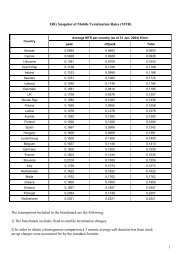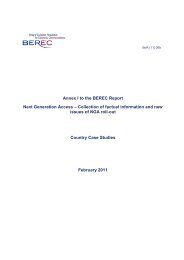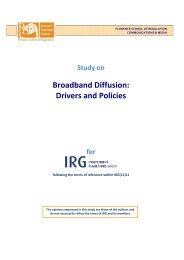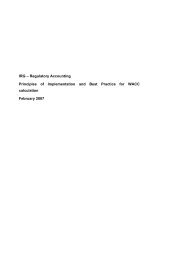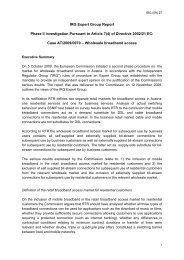16 Rev2b NGA Opinion Supplementary doc - IRG
16 Rev2b NGA Opinion Supplementary doc - IRG
16 Rev2b NGA Opinion Supplementary doc - IRG
Create successful ePaper yourself
Turn your PDF publications into a flip-book with our unique Google optimized e-Paper software.
ERG (07) <strong>16</strong>rev2b <strong>NGA</strong> <strong>Opinion</strong> <strong>Supplementary</strong> Doc 33 / 69<br />
This summer, ARCEP launched two public consultations on FttH, the first dealing with the<br />
competitive situation concerning access to ducts and the possible regulation of ducts with a<br />
view to rolling out high-speed broadband local loops, the second dealing with the sharing<br />
among operators of the last segments of the optical local loop in order to limit the amount of<br />
work carried out in buildings.<br />
Access to ducts<br />
Digging trenches and laying cables to buildings accounts for approximately two thirds of the<br />
cost of rolling out the optical fibre local loop. In less densely built-up areas, the cost of such<br />
civil engineering work is higher and rapidly becomes prohibitive.<br />
France Telecom is currently rolling out fibre in its ducts, which were inherited by the former<br />
monopoly. A certain number of these ducts are not occupied and can be used to roll out FttH<br />
networks.<br />
The former telephone service monopoly has therefore given France Telecom a major advantage<br />
as far as the development of high-speed broadband networks is concerned. Against<br />
this, it is unlikely that competition will be able to develop in smaller towns if alternative operators<br />
are required to replicate all the necessary civil engineering work in such localities.<br />
ARCEP has therefore written a public consultation with respect to the competitive situation<br />
concerning access to electronic communications ducts and the possible regulation of this<br />
access. The objective of this consultation is to enable all operators to have access to these<br />
infrastructures. It would then be possible to achieve fair competition, based on merit, between<br />
operators in the rollout of high-speed broadband networks.<br />
The aim of such regulation, focused on these essential infrastructures, would be to encourage<br />
investment and to guarantee infrastructure-based competition in the local loop segment.<br />
It could reduce the need for asymmetric regulation of the higher network layers and avoid the<br />
functional separation which as has been proposed by certain players.<br />
Sharing the last part of the fibre local loop<br />
Several operators are currently rolling out their own optical local loops in the same main cities,<br />
till the buildings, but also, within a building, to the apartments.<br />
In the long run it does not seem reasonable for each optical local loop operator to have its<br />
own dedicated cables and optical connectors in each building and each separate apartment.<br />
The amount of work involved would cause considerable inconvenience to the building’s occupants<br />
and co-owners. However, people must be able to change broadband operator without<br />
having to move home!<br />
The last part of the fibre local loop must therefore be shared by several operators. The second<br />
public consultation written by ARCEP concerns the technical, financial and legal issues<br />
raised by such shared usage. In view of the complexity of this subject, which affects a number<br />
of different aspects of the sector, certain questions require changes to the corresponding<br />
legal and regulatory framework.



